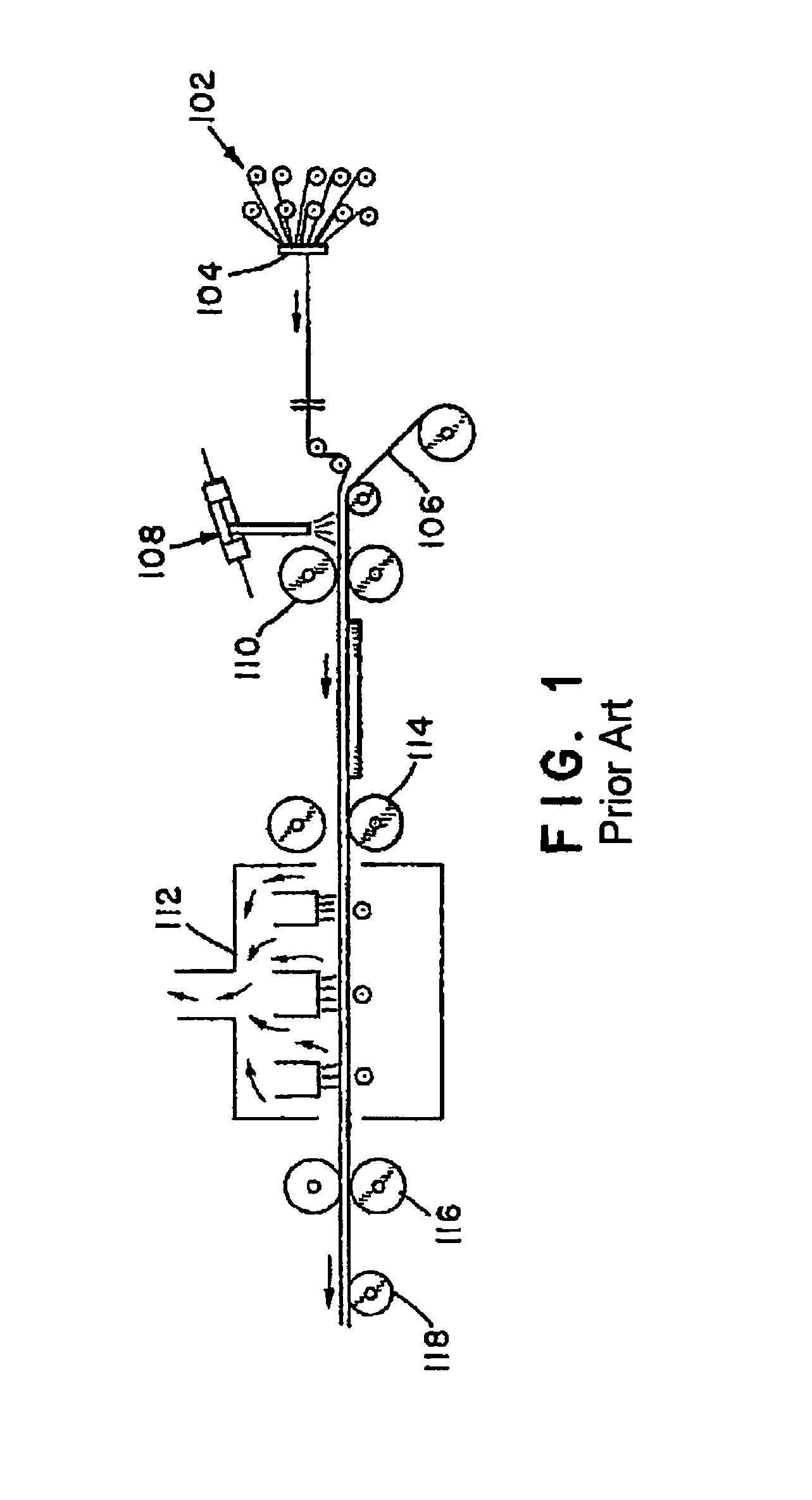Hybrid laminated fiber sheets
a technology of laminated fibers and unidirectional fibers, applied in the direction of synthetic resin layered products, transportation and packaging, other domestic articles, etc., can solve the problems of high-strength fibers intrinsically expensive, production capacity may not meet all needs, and is typically more expensive to produ
- Summary
- Abstract
- Description
- Claims
- Application Information
AI Technical Summary
Problems solved by technology
Method used
Image
Examples
example 1
[0071]A continuous roll of a unidirectional fiber prepreg was prepared from p-phenylene terephthalamide aramid fibers as described in Comparative Example 1. The aramid prepreg contained 16 wt. % of a matrix consisting of KRATON® D1107 isoprene-styrene-isoprene block copolymer elastomer. Applied to one surface of the prepreg was a 0.35 mil (0.0089 mm) thick polyethylene film.
[0072]A continuous roll of unidirectional fiber prepreg was prepared from poly(p-phenylene-2-6-benzobisthiazole) PBO fibers as described in Comparative Example 2. The PBO prepreg contained 16 wt. % of a matrix consisting of KRATON® D 1107 isoprene-styrene-isoprene block copolymer elastomer. The prepreg was formed on strippable release paper.
[0073]The aramid and PBO prepreg rolls were placed on the cross-plying machine described in U.S. Pat. No. 5,173,138. The prepregs were cross-plied 0° / 90° and consolidated under heat and pressure with the polyethylene film and the release paper on the outside surfaces to create...
example 2
[0077]Rolls of p-phenylene terephthalamide copolymer aramid fibers, and rolls of PBO fiber were placed on a creel 102 of the apparatus illustrated schematically in FIG. 1 and described above. The aramid fibers were reported by the manufacturer, to possess a tenacity of 24 grams / denier. The PBO fibers were reported by the manufacturer to possess a tenacity of 37 grams / denier. The rolls were arranged so that the aramid and PBO fibers alternated side-by-side as they were led into the combing station 104. A unidirectional prepreg was formed with fibers of aramid and PBO alternating in a direction transverse to the fiber direction. The periodic distance between fibers of the same composition was 4.6 mm. The hybrid prepreg contained 16 wt. % of a matrix consisting of KRATON® D1107 isoprene-styrene-isoprene block copolymer elastomer. Applied to one surface of the prepreg was a 0.35 mil (0.0089 mm) thick polyethylene film. Two continuous rolls of identical unidirectional hybrid aramid / PBO p...
examples 3-17
[0086]Hybrid laminates of the invention are prepared according the procedures of Example 1 having the compositions and constructions shown in Table II. The laminates are comprised of pairs of laminae comprising unidirectional fibers in a matrix, the fiber composition of a first lamina of a given pair being the same as the fiber composition of the second lamina of the given pair, the direction of fibers in a lamina being normal to the direction of fibers in an adjacent lamina, and the laminae being bonded together in stacked array. The laminates are balanced and symmetrical.
[0087]It is believed that articles consisting of assemblies of the laminates of Table II will have ballistic-resistance (V50 and SEAT) at least as great as the weight average properties of their constituents and will meet the requirements of NIJ Standard 0101.04 Revision A, for Type IIA body armor and / or NIJ Standard 0115.00 for Type 1 stab protection.
[0088]
TABLE IIPairs of LaminaeWt. % of LaminateComprised ofMatr...
PUM
| Property | Measurement | Unit |
|---|---|---|
| diameter | aaaaa | aaaaa |
| periodic distance | aaaaa | aaaaa |
| periodic distance | aaaaa | aaaaa |
Abstract
Description
Claims
Application Information
 Login to View More
Login to View More - R&D
- Intellectual Property
- Life Sciences
- Materials
- Tech Scout
- Unparalleled Data Quality
- Higher Quality Content
- 60% Fewer Hallucinations
Browse by: Latest US Patents, China's latest patents, Technical Efficacy Thesaurus, Application Domain, Technology Topic, Popular Technical Reports.
© 2025 PatSnap. All rights reserved.Legal|Privacy policy|Modern Slavery Act Transparency Statement|Sitemap|About US| Contact US: help@patsnap.com



